Homemade Eyepieces
Eyepieces are much easier to build than most people think. I have never understood why so few telescope makers build their own. Although my methods used sophisticated equipment unavailable to most hobbyists, it isn't necessary to use such equipment. A simple, small bench lathe, a caliper, and a few cutting tool are all that is needed. Wood workers can make eyepiece barrels on a wood lathe. All of the eyepieces on this page were made from surplus optics available from the sources listed on the links page.
Please note that I build only for my own instruction and that none of these eyepieces are for sale.
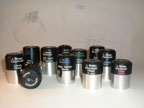 I experimented with a variety of eyepiece designs and eventually produced a set composed of five Plossls, three modified Kellners, one Erfle, one experimental four-element of my own design, and one orthoscopic. (Not shown here are the two-inch eyepieces). Each of these designs is discussed below.
I experimented with a variety of eyepiece designs and eventually produced a set composed of five Plossls, three modified Kellners, one Erfle, one experimental four-element of my own design, and one orthoscopic. (Not shown here are the two-inch eyepieces). Each of these designs is discussed below.
Click on the photos to enlarge.
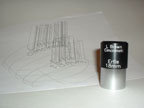 All of my eyepiece designs were first constructed in virtual reality in SurfCam or SolidWorks, three-dimensional surface and solid modeling programs. I used Surfcam to project text onto a cylindrical surface and posted the file to an NC machine which cut the text into the black barrel. I then sprayed paint over the black urethane barrel and sanded off everything that was not down in the carved grooves, leaving a finished product that looks like it came from a factory in Japan. Talk about overkill! But it was fun.
All of my eyepiece designs were first constructed in virtual reality in SurfCam or SolidWorks, three-dimensional surface and solid modeling programs. I used Surfcam to project text onto a cylindrical surface and posted the file to an NC machine which cut the text into the black barrel. I then sprayed paint over the black urethane barrel and sanded off everything that was not down in the carved grooves, leaving a finished product that looks like it came from a factory in Japan. Talk about overkill! But it was fun.
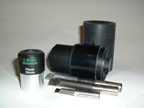 I began by mixing up a batch of Urethane with black coloring. This was poured into a tube and allowed to harden, giving me rods of black urethane to turn on a lathe. The long cutters are required to get inside the tube and create the internal diameters needed to hold the lenses. Since the exit opening is smaller than the eyelens (the lens nearest the eye) which is always smaller than the field lens, it was easy to step out the diameters in one operation, from one side. Some of the drawings behind the eyepieces will illustrate this.
I began by mixing up a batch of Urethane with black coloring. This was poured into a tube and allowed to harden, giving me rods of black urethane to turn on a lathe. The long cutters are required to get inside the tube and create the internal diameters needed to hold the lenses. Since the exit opening is smaller than the eyelens (the lens nearest the eye) which is always smaller than the field lens, it was easy to step out the diameters in one operation, from one side. Some of the drawings behind the eyepieces will illustrate this.
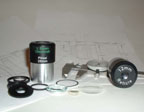 A good pair of calipers is necessary to measure the rings and spacers used to hold the lenses in place. A drop of superglue permanently bonds the urethane. The reticle eyepiece uses a glass military reticle held at the focal point, so that the etched lines are in focus. Each eyepiece was finished off with a field stop which sharply defines the apparant field of view. If the edges of the field of an eyepiece start to distort the image, a smaller field stop eliminates the bad area. You could probably enlarge the apparant field of view of any eyepiece by removing the field stop, but you would probably pick up some edge distortion. Also, the image would appear to fade away at the edges instead of being sharply defined. I did this intentionally in some of my ultra-wide angle eyepieces since it helps increase the "space-walk" effect. The effect is so impressive that I can live with a little distortion.
A good pair of calipers is necessary to measure the rings and spacers used to hold the lenses in place. A drop of superglue permanently bonds the urethane. The reticle eyepiece uses a glass military reticle held at the focal point, so that the etched lines are in focus. Each eyepiece was finished off with a field stop which sharply defines the apparant field of view. If the edges of the field of an eyepiece start to distort the image, a smaller field stop eliminates the bad area. You could probably enlarge the apparant field of view of any eyepiece by removing the field stop, but you would probably pick up some edge distortion. Also, the image would appear to fade away at the edges instead of being sharply defined. I did this intentionally in some of my ultra-wide angle eyepieces since it helps increase the "space-walk" effect. The effect is so impressive that I can live with a little distortion.
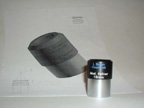 My modified Kellner is simply the Kellner design turned upside down. By placing the shorter focal length lens on top of the longer one, the apparant field of view is increased. This is not a new idea. Edmund has done it for years with their RKE eyepieces, although they have taken it a step further and achieved superior results by carefully matching two different types of glass to reduce chromatic aberrations.
My modified Kellner is simply the Kellner design turned upside down. By placing the shorter focal length lens on top of the longer one, the apparant field of view is increased. This is not a new idea. Edmund has done it for years with their RKE eyepieces, although they have taken it a step further and achieved superior results by carefully matching two different types of glass to reduce chromatic aberrations.
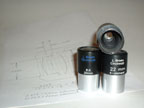 The 20mm eyepiece is a modified Kellner. The 22mm eyepiece has four elements and doesn't quite fit into any design category, but it works quite well. The four elements are a double convex eyelens, an achromat (two lenses glued together) and a plano convex field lens. Some people would call it an old-style Konig. The upended eyepiece shows a field stop.
The 20mm eyepiece is a modified Kellner. The 22mm eyepiece has four elements and doesn't quite fit into any design category, but it works quite well. The four elements are a double convex eyelens, an achromat (two lenses glued together) and a plano convex field lens. Some people would call it an old-style Konig. The upended eyepiece shows a field stop.
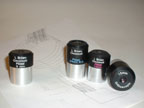 The Plossl is the easiest design to build, consisting of two achromats nearly touching. An achromat is a compound lens made from two pieces of glass, each lens having optical properties that cancel out most of the aberrations of the other lens. The image is usually quite sharp with a field of view of 50 degrees. I found it difficult to build a bad Plossl, as long as I stayed within normal design parameters (see the links page for basic eyepiece design).
The Plossl is the easiest design to build, consisting of two achromats nearly touching. An achromat is a compound lens made from two pieces of glass, each lens having optical properties that cancel out most of the aberrations of the other lens. The image is usually quite sharp with a field of view of 50 degrees. I found it difficult to build a bad Plossl, as long as I stayed within normal design parameters (see the links page for basic eyepiece design).
I built only one orthoscopic eyepiece, owing to the scarcity of good triplets. It is made with four elements in two groups--a triplet field lens and a single positive eye lens. Color correction, contrast, and resolution are superior to any other design. The only reason they are not popular today is the narrow field of view. The orthoscopic is still the best choice for viewing planets and details on the sun and moon, where a wide field of view is unnecessary.